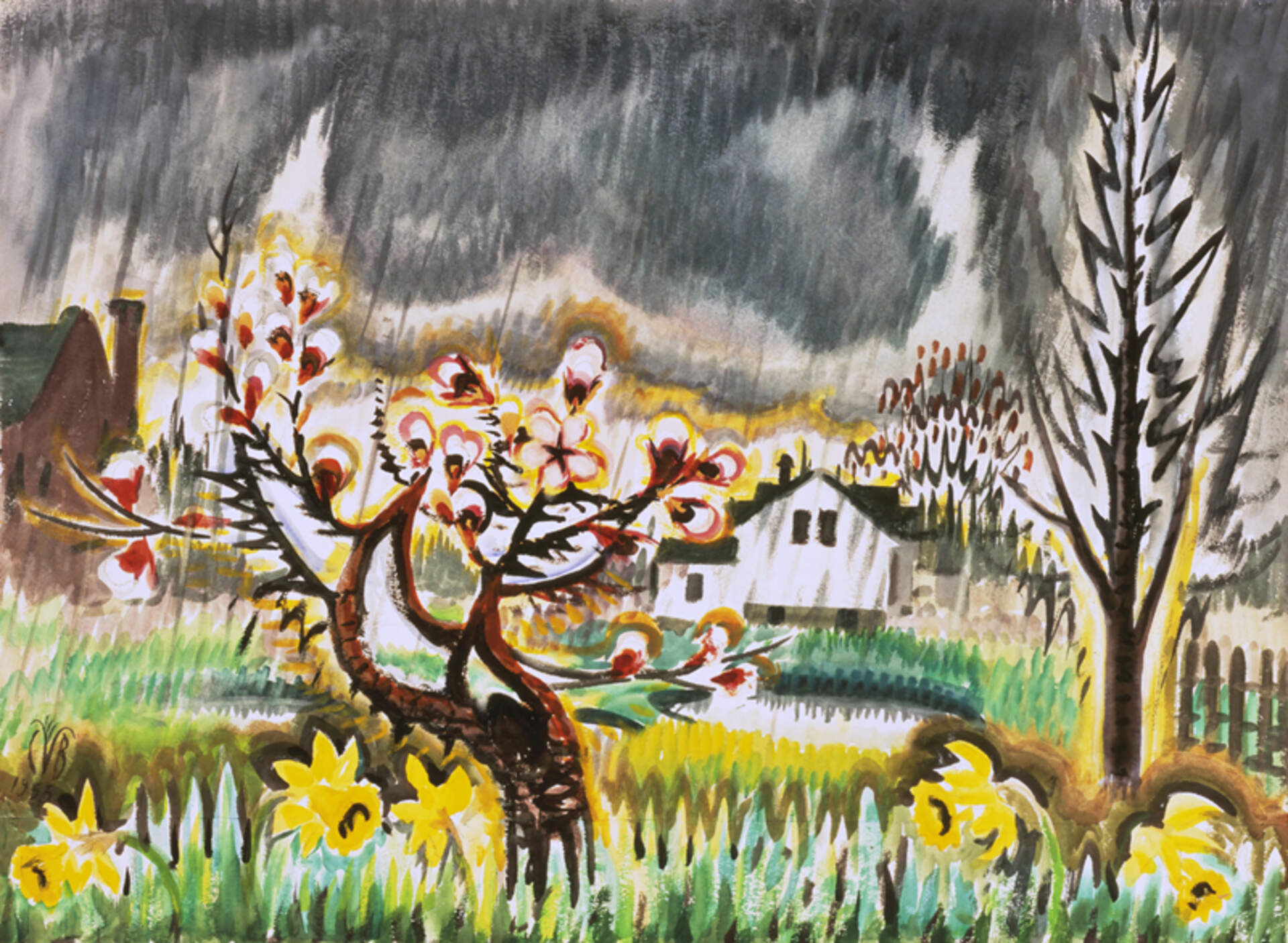
Charles E. Burchfield (1893-1967), Spring Thunderstorm aka Spring Shower, 1955; Watercolor and charcoal on joined paper, 29 7/8 in. x 40 1/8 inches; Akron Museum of Art, Gift of Mrs. Mary S. Huhn, Mrs. Dorothy S. Steinberg, and Mr. John F. Seiberling, Jr. in memory of their father, Mr. J. Frederick Seiberling 1964.11
Charles E. Burchfield, Journals, Vol. 60, June 15, 1961
Saturday, Jun 15, 2019
June 15 – Thurs.
P.M. – to Gardenville Elementary School to show my paintings to and talk to the sixth grade pupils –
Earlier the principal (Miss Marie Munn) had said the pupils, following a visit to see my drawings show at the Goodman Gallery, had expressed the desire to honor my work at their graduation exercises. The plan was to have me pick out six of my “favorite” pictures (3 for each class) — the honor pupils were to write their impressions of them, recite them and then I was to give a little talk. I felt that I could not go through with such a program, so I suggested an alternative – I was to meet the class some afternoon near to graduation time, show them some of my work, talk to them and let them ask questions or make comments. Then, instead of my choosing pictures for them, I suggested I give them the Whitney catalogue to look at, and the pupils were to make their own choices. Miss Munn thought this was a good idea.
Even before the event, I began to look forward to it – I have always felt the years of 10 to 12 were the “golden” age of childhood, the time when they are least self-conscious, and of easy access. I made up my mind I would not treat them as children — not “talk down” to them, but show them the same pictures I would to a connoisseur or museum director, and make the same comments
The event proved to be one of the happiest and most rewarding experiences of my entire career.
I picked out the following paintings
1. The Constant Leaf (1959)
2. Arctic Owl and Winter Moon (1959)
3 - Spring Thunderstorm (1961)
4 - Wild Bleeding Hearts (1961)
5 - Trout Lilies (1948-61)
6 - The Green Lane (1961)
7 - Storm at Sunset (1959)
8 - Hot July Wind (1955-60)
9 - Sun Images (1952)
10 - Falling Leaves – 1955-59
11 - Orion in December (1959)
12 - The Peace of Christmas (1917-47)
13 - The Christmas Tree – (1959 – of the 1958 Christmas)
(Inasmuch as these were all nature themes with seasonal over-tones, I arranged them in a calendar sequence.)
First the honor pupils line up and recited their appraisals of the pictures that had been chosen as favorites of the two classes – (The choices were significant – all were nature themes, and Miss Munn said even the ones that failed to get a majority vote were also pure nature –)
The pictures they chose were:
Dandelion Seed-Balls & Trees (1917)
Cricket Chorus in the Arbor (1917)
The Three-Trees – (1932-1946)
September Wind & Sunlight (1953)
Moonflowers at Dusk (1952)
Winter Moonlight – (1951)
Their descriptions, brief and to the point, had been committed to memory, and they delivered them charmingly.
Before showing each picture, I gave a short description of its inspiration & subject matter.
The first two evoked no audible response, altho they were very quiet and attentive. But when I put up the fantastic “Spring Thunderstand” [sic] a chorus of “Wow,” greeted it, and I knew then the project was “in” – Those “Wows” were very sweet to my ears — It happened on several of the others.
My decision to treat them as adults proved a wise one (I have read somewhere that adults always under-rate the maturity and intelligence of children –) they asked intelligent questions and made comments that showed they got the message of the work. One little girl, looking at the Spring Thunderstorm –Storm” [sic] asked “How do you make everything look so alive – as though it were actually there” – Unfortunately I could not think of anything to answer to this, but I impressed it on her, that I considered her question most complimentary, and she seemed pleased.
On the “Peace of Christmas” one boy made this comment “The top of that chimney makes you feel that there is a nice warm fire in the stove below” which was exactly what I had intended in my treatment of the chimney top –
Afterwards we set all the paintings up so they could see them all at once, and examine them more closely –
One child asked for my autograph, which set the whole class off, and all asked for one, whether they wanted it or not – However I tried to make it as personal as possible asking each their name.
After the children were dismissed, we were asked to join the teaching staff in the lunch-room for tea, which was a very pleasant hour. We left with a warm glow.
—Charles E. Burchfield, June 15, 1961